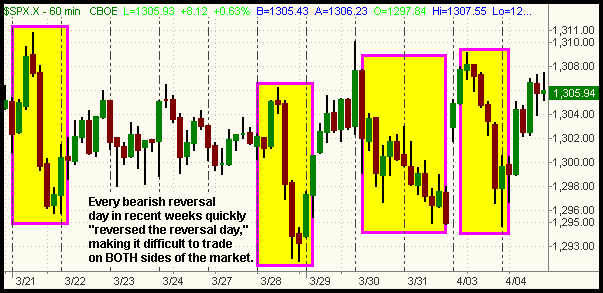Nasdaq at 5-year highs
As we have become
accustomed to over the past several weeks, the broad market failed to
follow-through on the previous afternoon’s bearish reversal. Instead, the
S&P 500
(
SPX |
Quote |
Chart |
News |
PowerRating) recovered most of Monday’s intraday loss, while the Nasdaq
Composite
(
COMP |
Quote |
Chart |
News |
PowerRating) closed near the middle of that day’s range. This
translated to a 0.6% gain in the S&P 500, 0.5% gain in the Dow Jones
Industrial Average, and a 0.4% advance in the Nasdaq Composite. The small-cap
Russell 2000 rallied 0.4% and the S&P Midcap 400 finished 0.3% higher. The
moderate gain in the Nasdaq was enough to enable the index to close at new
5-year highs but the S&P remained in its choppy, sloppy three-week range.
Turnover was mixed yesterday, preventing the
broad market from realizing bullish “accumulation days.” Total volume
in the Nasdaq edged up 3%, but volume in the NYSE was 11% lighter than the
previous day’s level. Despite its gain, market internals in the Nasdaq were
negative and did not confirm yesterday’s rally to a 5-year highs. Just like
the previous day, declining volume in the Nasdaq exceeded advancing volume by a
margin of approximately 3 to 2 even though it made 5-year highs. The NYSE
internals, however, were positive by the same margin. Not surprisingly, turnover
in the NYSE was once again below its 50-day average level. In recent weeks, the
broad market’s volume levels have been quite representative of lethargic summer
activity, even though it is not. Unfortunately, choppy and directionless trading
is typically the end result of light turnover, and we certainly have had no
shortage of that!
One sector that has just broken out above
resistance is the Internet Index ($GIN). After a 14% correction off its January
2006 high, the $GIN came into support of its 200-day moving average last month.
On March 29, the index broke out above its two-week trading range and began to
show signs of life. It then consolidated near the high of the range for three
days before rallying above its 50-day moving average and primary downtrend line.
Being that yesterday was the first time the $GIN closed above its 50-day MA
since January 27, it appears a reversal of its multi-month downtrend may be
shaping up:

Because of the recent relative strength in the
Internet Index, we view any minor retracements in the sector as buying
opportunities. At present, there is only one major ETF, the Internet HOLDR (HHH),
that specifically tracks the Internet sector. Other ETF families have Internet
stocks mixed in with Software or Networking stocks. Unfortunately, HHH does not
closely follow the $GIN index because it lacks the inclusion of Google. Just as
SMH has been lagging the $SOX index, HHH has been lagging the $GIN index. As
such, you are probably better off building your own “synthetic ETF” by
simultaneously trading a small basket of the leading Internet stocks as opposed
to trading HHH.
If the market has been preventing you from
staying with your positions for more than a day in recent weeks, a brief look at
the S&P’s intraday action over the past several weeks will help you
understand why this has been the case. Check out the incredibly indecisive
nature of the S&P 500 on the hourly chart below:

Highlighted above, you will see there have been
no less than four bearish reversal days since March 21 that have simply
led to “reversals of the reversal days” in each of the following
sessions. It’s no wonder that many short-term swing traders, including yours
truly, have had difficulty remaining in both long and short positions for more
than a day before getting whipsawed out. When the market enters into a spastic
phase like this, it is costly to try to anticipate when the erratic chop will
end — doing so will only result in getting stopped out excessively. Instead,
your best bet is to reduce both your average position size and the
quantity of open positions. It’s also a good idea to be positioned on both sides
of the market until the market proves it can break out of the range.
To conclude on a different note, we wish to bring
your attention to an article that appeared in today’s issue of Investors
Business Daily (IBD). After presenting at the World Series of ETFs last
Friday, I was approached by an IBD reporter and briefly interviewed on my
thoughts regarding the StreetTRACKS Gold Trust (GLD). A portion of that
interview appeared in the ETF section of today’s IBD. In case you are not a
subscriber, you may click
here to view the article online.
Open ETF positions:
Short BBH (regular subscribers to The
Wagner Daily receive detailed stop and target prices on open positions
and detailed setup information on new ETF trade entry prices. Intraday e-mail
alerts are also sent as needed.)
Deron Wagner is the head trader of Morpheus Capital Hedge Fund and founder of
Morpheus Trading Group (morpheustrading.com),
which he launched in 2001. Wagner appears on his best-selling video, Sector
Trading Strategies (Marketplace Books, June 2002), and is co-author of both The
Long-Term Day Trader (Career Press, April 2000) and The After-Hours Trader
(McGraw Hill, August 2000). Past television appearances include CNBC, ABC, and
Yahoo! FinanceVision. He is also a frequent guest speaker at various trading and
financial conferences around the world. For a free trial to the full version of
The Wagner Daily or to learn about Deron’s other services, visit morpheustrading.com
or send an e-mail to deron@morpheustrading.com
.
